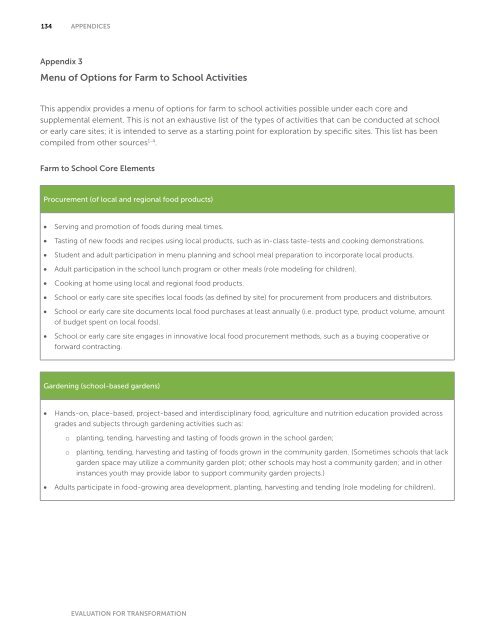Framework-08-25-14_web
Framework-08-25-14_web
Framework-08-25-14_web
Create successful ePaper yourself
Turn your PDF publications into a flip-book with our unique Google optimized e-Paper software.
134 APPENDICESAppendix 3Menu of Options for Farm to School ActivitiesThis appendix provides a menu of options for farm to school activities possible under each core andsupplemental element. This is not an exhaustive list of the types of activities that can be conducted at schoolor early care sites; it is intended to serve as a starting point for exploration by specific sites. This list has beencompiled from other sources 1-4 .Farm to School Core ElementsProcurement (of local and regional food products)• Serving and promotion of foods during meal times.• Tasting of new foods and recipes using local products, such as in-class taste-tests and cooking demonstrations.• Student and adult participation in menu planning and school meal preparation to incorporate local products.• Adult participation in the school lunch program or other meals (role modeling for children).• Cooking at home using local and regional food products.• School or early care site specifies local foods (as defined by site) for procurement from producers and distributors.• School or early care site documents local food purchases at least annually (i.e. product type, product volume, amountof budget spent on local foods).• School or early care site engages in innovative local food procurement methods, such as a buying cooperative orforward contracting.Gardening (school-based gardens)• Hands-on, place-based, project-based and interdisciplinary food, agriculture and nutrition education provided acrossgrades and subjects through gardening activities such as:o planting, tending, harvesting and tasting of foods grown in the school garden;o planting, tending, harvesting and tasting of foods grown in the community garden. (Sometimes schools that lackgarden space may utilize a community garden plot; other schools may host a community garden; and in otherinstances youth may provide labor to support community garden projects.)• Adults participate in food-growing area development, planting, harvesting and tending (role modeling for children).EVALUATION FOR TRANSFORMATION


